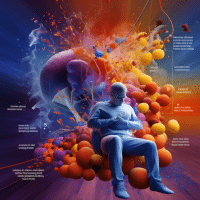Diabetes and Cultural Awareness: Celebrating Diversity in Diabetes Education
 Diabetes and Cultural Awareness
Diabetes and Cultural Awareness
Introduction
Diabetes and Cultural Awareness: is a condition that affects people from all walks of life, and it is important to recognize the cultural differences that can impact diabetes education. Diabetes and culture are intertwined, and it is essential to understand the cultural context of diabetes in order to provide the best possible care. At Workflow, we believe that celebrating diversity in diabetes education is key to providing the best care for our patients.
We strive to create an inclusive environment that respects and celebrates the cultural differences of our patients. Our team of experts is dedicated to providing culturally competent diabetes education that is tailored to the individual needs of each patient. We understand that diabetes education is not a one-size-fits-all approach, and we are committed to providing the best care for our patients.

Understanding the Impact of Culture on Diabetes Education
Diabetes is a condition that affects people from all walks of life, and it is important to understand the impact of culture on diabetes education. Diabetes is a complex condition, and cultural differences can play a role in how people understand and manage their diabetes. For example, some cultures may have different beliefs about the causes of diabetes, or different approaches to managing the condition.
It is important to recognize the diversity of cultural backgrounds when it comes to diabetes education. By understanding the cultural context of diabetes, healthcare providers can better tailor their education and support to meet the needs of their patients. This can help to ensure that everyone has access to the information and resources they need to manage their diabetes.
By celebrating diversity in diabetes education, healthcare providers can ensure that everyone has access to the information and resources they need to manage their diabetes. This can help to create a more inclusive and supportive environment for people living with diabetes, regardless of their cultural background.
The Significance of Diabetes and Cultural Awareness Education
1. Individualized Care
Diabetes and cultural awareness education recognizes that individuals have unique cultural backgrounds, beliefs, and practices that influence their approach to diabetes management. Providing individualized care that respects and incorporates cultural preferences can lead to better patient outcomes.
2. Reducing Disparities
Cultural disparities exist in diabetes prevalence, complications, and access to care. Cultural awareness aims to address these disparities by tailoring education and interventions to specific cultural contexts, reducing the impact of social determinants of health.

3. Effective Communication
Effective communication between healthcare providers and patients is essential for successful diabetes management. Understanding cultural nuances in communication styles, language preferences, and health literacy levels improves the delivery of diabetes education.
4. Promoting Inclusivity
Diabetes and cultural awareness promotes inclusivity in diabetes care and education. It ensures that everyone, regardless of their cultural background, feels respected, understood, and valued in their diabetes journey.
Exploring Cultural Beliefs and Practices Related to Diabetes
When it comes to diabetes and cultural awareness, culture plays an important role in how we understand and manage the condition. Diabetes and culture are intertwined, as cultural beliefs and practices can influence how people with diabetes view their condition and how they manage it.
For example, some cultures may view diabetes as a sign of spiritual imbalance, while others may view it as a sign of physical weakness. Additionally, Diabetes and cultural beliefs and practices can influence how people with diabetes view their diet and lifestyle. For example, some cultures may view certain foods as being beneficial for diabetes, while others may view them as being harmful.
It is important to recognize and celebrate the diversity of cultural beliefs and practices related to diabetes. By understanding and respecting the cultural beliefs and practices of people with diabetes, we can provide better diabetes education and support. This can help to ensure that people with diabetes have access to the resources and support they need to manage their condition.
Recognizing the Role of Language in Diabetes Education
Language is an important part of culture, and it can be a powerful tool in diabetes and cultural education. Diabetes educators must be aware of the cultural and linguistic backgrounds of their patients in order to provide the best care. For example, if a patient speaks Spanish, it is important to provide diabetes education materials in Spanish. This will help ensure that the patient understands the information and can make informed decisions about their diabetes care.
Diabetes educators must also be aware of the cultural and linguistic nuances of their patients. For example, some cultures may have different beliefs about diabetes and its treatment. It is important for diabetes educators to be aware of these beliefs and to be respectful of them. By understanding the diabetes and cultural and linguistic backgrounds of their patients, diabetes educators can provide the best care possible.
In conclusion, diabetes and cultural awareness educators must be aware of the cultural and linguistic backgrounds of their patients in order to provide the best care. By understanding the cultural and linguistic nuances of their patients, diabetes educators can ensure that their patients understand the information and can make informed decisions about their diabetes care. By recognizing the role of language in diabetes education, diabetes educators can celebrate diversity and provide the best care possible.

Strategies for Celebrating Diversity in Diabetes Education
When it comes to diabetes and cultural education, it is important to recognize the role that culture plays in the lives of those living with diabetes. Diabetes and cultural awareness are intertwined, and it is essential to understand the cultural context of diabetes in order to provide the best possible care. Celebrating diversity in diabetes education is an important part of providing culturally competent care.
By recognizing and respecting the diabetes and cultural beliefs and practices of those living with diabetes, healthcare providers can create an environment of trust and understanding. This can be done by incorporating cultural elements into diabetes education, such as using culturally appropriate language, providing culturally relevant resources, and understanding the cultural values and beliefs of those living with diabetes. By doing so, healthcare providers can ensure that diabetes education is tailored to the individual and their cultural needs.
Tips for Creating an Inclusive Diabetes Education Environment
Creating an inclusive diabetes education environment is essential for providing quality care to all patients. Diabetes and culture are intertwined, as cultural beliefs and practices can influence how people manage their diabetes. It is important to recognize and respect the cultural differences of each patient, and to provide diabetes education that is tailored to their individual needs.
By understanding the diabetes and cultural context of each patient, healthcare providers can better equip them with the knowledge and skills to manage their diabetes. This includes understanding the patient’s language, beliefs, values, and customs. It is also important to recognize the impact of social determinants of health, such as access to healthcare, education, and economic resources.
By taking the time to understand the cultural context of each patient, healthcare providers can create an inclusive diabetes education environment that celebrates diversity and provides quality care to all patients.
Overcoming Challenges in Cultural Awareness
While celebrating diversity in diabetes and cultural education is essential, it comes with its challenges. Here are some common obstacles and strategies to overcome them:
1. Language Barriers
Challenge: Language differences can hinder effective communication. Strategy: Provide interpretation services and translated materials to bridge language gaps.
2. Limited Cultural Understanding
Challenge: Healthcare providers may have limited knowledge of certain cultural practices. Strategy: Encourage ongoing learning and cultural competency training.
3. Stereotyping
Challenge: Healthcare providers may unintentionally stereotype patients based on cultural backgrounds. Strategy: Promote awareness of biases and emphasize individualized care.
4. Patient Resistance
Challenge: Some patients may resist cultural discussions due to stigma or discomfort. Strategy: Create a safe and nonjudgmental environment for open dialogue.
5. Resource Constraints
Challenge: Limited resources can hinder the implementation of culturally tailored programs. Strategy: Seek partnerships with community organizations and leverage available resources effectively.
Conclusion
In conclusion, diabetes and culture are inextricably linked. Diabetes education must be tailored to the cultural needs of the patient in order to be effective. By celebrating diversity in diabetes and cultural education, healthcare providers can ensure that their patients receive the best possible care. By understanding the cultural context of diabetes, healthcare providers can better understand the needs of their patients and provide them with the best possible care. By recognizing the importance of cultural awareness in diabetes education, healthcare providers can ensure that their patients receive the best possible care.
In conclusion, Diabetes and cultural education must be tailored to the cultural beliefs and practices of the patient in order to be effective. By recognizing the role of language, celebrating diversity, and creating an inclusive environment, healthcare providers can ensure that their diabetes education is culturally appropriate and effective. Diabetes education should be a collaborative effort between healthcare providers and patients, and by understanding the impact of culture on diabetes education, healthcare providers can ensure that their patients receive the best care possible. By celebrating diversity in diabetes education, healthcare providers can ensure that all patients receive the best care possible.
Frequently Asked Questions
Q1: What is the impact of diabetes and cultural education?
Culture plays an important role in diabetes education, as it can influence how people understand and respond to diabetes-related information. Cultural beliefs and practices can shape how people view diabetes, how they manage their diabetes, and how they interact with healthcare providers. It is important to recognize and respect cultural differences in order to provide effective diabetes education.
Q2: What are some common cultural beliefs and practices related to diabetes?
Different cultures have different beliefs and practices related to diabetes. For example, some cultures may view diabetes as a sign of spiritual imbalance, while others may view it as a sign of physical weakness. Additionally, some cultures may have specific dietary practices or traditional remedies that are used to manage diabetes. It is important to be aware of these cultural beliefs and practices in order to provide effective diabetes education.
Q3: How does language play a role in diabetes education?
Language can be a barrier to effective diabetes education. People may not understand medical terminology or be able to communicate their needs to healthcare providers if they do not speak the same language. It is important to recognize the role of language in diabetes education and to provide resources and support for people who do not speak the same language as their healthcare providers.
Q4: What strategies can be used to celebrate diversity in diabetes education?
Celebrating diversity in diabetes education is important in order to provide effective and inclusive care. Strategies for celebrating diversity include providing culturally-sensitive education materials, using interpreters when necessary, and creating an inclusive environment that respects and values different cultures.
Q5: What tips can be used to create an inclusive diabetes education environment?
Creating an inclusive diabetes education environment is important in order to provide effective care. Tips for creating an inclusive environment include being aware of cultural differences, using language that is respectful and non-judgmental, and providing resources and support for people from different cultures.
Q6: How can healthcare providers ensure that they are providing culturally-sensitive diabetes education?
Healthcare providers can ensure that they are providing culturally-sensitive diabetes education by being aware of cultural differences, using language that is respectful and non-judgmental, and providing resources and support for people from different cultures. Additionally, healthcare providers should be open to learning about different cultures and be willing to adjust their approach and materials as needed.


















